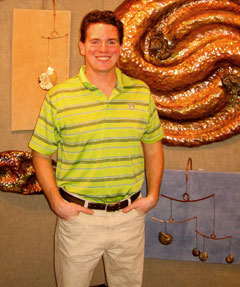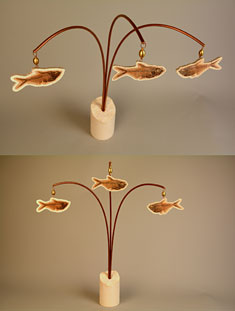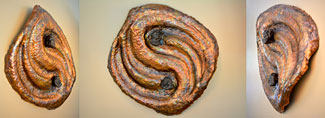JI9 Sculpting: Breathing New Life to Ancient History Through Fossils, Meteorites and Copper
 1920 Size Careen. Spanning 36 x 24 inches, this 20-gage copper wall piece with a meteorite from Argentina's Campo Del Cielo crater carries strong movement with it.
1920 Size Careen. Spanning 36 x 24 inches, this 20-gage copper wall piece with a meteorite from Argentina's Campo Del Cielo crater carries strong movement with it. Photograph courtesy of James Ivy
By pairing fossils and copper, artist James Ivy breathes new life into natural history artifacts, showcasing the beauty of both. With a metalwork background developed during his time at the Austin Community College, one of the top metal arts schools in the nation, Ivy began incorporating fossils and even meteorites into his copper sculptures several years ago.
The idea came to him after his father suggested one Christmas that he look into natural history’s luring possibilities; his family operates a major auctioneering business in Texas and sometimes stumbles into this more science-minded arena. His father then introduced him to an annual event known as the Tucson Gem and Mineral Show hosted in Arizona each winter, with the venues spanning across many locations around the city for several weeks in a row.
Ivy pointed out that while the event has the words ‘gem’ and ‘mineral’ in its name, meteorites, fossilized fish, ammonites (sea creatures in spiral-shaped shells originating from several hundred million years ago before becoming extinct in the last few million years) and trilobites (the earliest known arthropods) are also a part of what vendors from all over the globe bring to the tables across the city when the shows are in full swing.
Ivy began passionately incorporating these natural artifacts by weaving them into his work. He then began his company JI9 Sculpture, where he handcrafts wall hangings, mobiles and standing sculptures. The copper in his standing and mobile sculptures, where sea creatures beckon in their own quieted history, take shape in wire form in designs that keep each piece moving even in stillness. He has some early stage concepts for floor pieces, too.
Ivy strives to bring attention to these ancient artifacts without jeopardizing their integrity as strong, powerful yet sometimes somewhat fragile pieces of history of the earth’s animal life.
“I never defame the surface of the fossil,” he points out.
Ivy’s fossilized fish supply mainly come from the Green River in Wyoming, where a small handful of varieties of swimming ones hardened into the underbed of the water around 40 to 50 million years ago. One of those fish, often in his pieces has the name Priscacara liops, or Prisky for short.
 James Ivy in his studio.
James Ivy in his studio.Photograph courtesy of James Ivy
“My goal is to take these pieces out of their security cases and into the living environment,” Ivy says. He hopes adding new motion to inanimate critters of the past will challenge people to think outside of traditional boxes of thought and view, helping them to learn more about the fossil's origins.
“I’ve always been really intrigued with earth materials, their shape and texture,” Ivy adds. “I always spend a lot of time outdoors and collected stones, lots of quartz and metals as a child.”
Since first attending the Tucson Gem and Mineral Show ritualistically, Ivy now buys about 50 artifacts each time and saves them to use throughout a year. But he also reaches out to the vendors later in the year if he finds himself nearly running out of his supply.
“It’s not about exactness—it’s about evoking emotions and concepts,” he says about what he intends for his art as others experience it. Bringing ancient creatures back to life in the minds of those who view his art is a strong component in what Ivy says he intends to accomplish through his sculptures.
“And I’m running low on meteorites and ammonites because people like them a lot,” Ivy says. “You’re growing and learning with every weld you make. And copper moves the way it wants to move, to a certain degree.”
Having relocated to Columbia, South Carolina from Austin, Texas about a year ago, Ivy had a good supply of copper materials he purchased from Farmers Copper in Galveston.
 Flying Fish Mobile 1920 - Flying Table Fish. This simple yet flowing design makes these fossilized fish almost lifelike as they dangle and turn below copper.
Flying Fish Mobile 1920 - Flying Table Fish. This simple yet flowing design makes these fossilized fish almost lifelike as they dangle and turn below copper.Photograph courtesy of James Ivy
But he is finally almost working his way through the last of the batch of copper and says he’ll soon be looking into new sources possibly closer to the East Coast studio he’s arranged in his garage where car tires never grace the floor. He is also looking to incorporate silicon bronze into his sculptures. Recently, Ivy developed smaller versions of his signature pieces that involve summoning, hammer-molded sweeps of copper with a small meteorite in the middle, tucked into a pocket within the shapely metal.
The solid iron meteorites he sources are often from between 4,000 and 5,000 years ago, known as Campo Del Cielo (translating to “Field of the Sky” in Spanish) from a crater north of Buenos Aires, Argentina.
Ivy points out that the meteorites from this region were first identified in 1576 during an expedition ordered by a governor in one of Argentina’s northernmost provinces.
Behind the meteorite in his copper wall sculptures is an earth magnet, which Ivy includes so that those who are looking at his pieces can literally take the artifact from outer space, hold it in their hands, feel its texture, see its shiny sections of surface and then place it back into the sculpture’s central pocket.
With this interactive effort, Ivy is always inching closer to provoking many a mind at the fingertips.
“People get sort of used to the mundane, a certain order of things,” Ivy says. Fortunately, his art thrives in another direction with a stimulation etched in a fresh appeal for the senses where an interest in science is easy to keep pushing forward.
So it makes sense then that sometimes people react in slight confusion or simply hinting that they don’t get the point of the piece. When they do suddenly understand and see what Ivy is trying get them to break out of in their usual thought processes, he says witnessing the evolution of their knowledge is one of the most rewarding components in his work.
With sculptures featured in City Art, a gallery in Columbia not far from where he now lives, Ivy’s name is becoming more and more known on the local level; his piece titled Meteoric Atmospheric Entry is on display at the gallery, with the copper of the sculpture successfully and compellingly emulating exactly what its description implies.
 Dancing-Pair All Angles 1920 -- Dancing Pairo of Meteorites. These two meteorites from Argentina swim well in their dance atop seemingly quick-flowing copper in many hues through heat treatment.
Dancing-Pair All Angles 1920 -- Dancing Pairo of Meteorites. These two meteorites from Argentina swim well in their dance atop seemingly quick-flowing copper in many hues through heat treatment.Photograph courtesy of James Ivy
While traveling in Tennessee with his wife last month, Ivy mentioned to her the idea of creating sconces and adorning them with fossils instead of crystals as a way to bring his beloved arena of natural history into a buildings and homes in an everyday sense. So this is an idea he may be testing out in his sculpting in the near future.
Ivy has noticed that the nature of his work leads fine art galleries and those running natural history shows to persuade him to reach out to the other and vice versa because his art is such an unfamiliar dynamic between metal, meteorites and fossils.
“It’s interesting because my work is art, and it’s also natural history, and so I’m in a very grey area right in between the two worlds,” he says. “Each one of the two areas doesn’t exactly know what to do with me. The natural history places look at my work and say, ‘That’s fine art—you need to go to galleries with fine art.’ And the galleries with fine art say, ‘That’s natural history—you need to go to natural history venues.’ It’s just such a new ground and area that I’m forging essentially, so it’s a battle.”
Nonetheless, Ivy is lining himself up for a few fine art shows in Florida and some natural history shows as well within the next year. He’s more recently started exploring the possibility of shows along the East Coast since that part of the country is now his home.
And he’ll be participating in Tucson Gem and Mineral Show next February, with plenty of shopping planned for his artifact supply as well.
“I enjoy learning from copper—striking it, watching it move, brazing it, kind of like tack welding,” Ivy says. “It’s just a growing of knowledge for me.”
Resources:
Also in this Issue:
- JI9 Sculpting: Breathing New Life to Ancient History Through Fossils, Meteorites and Copper
- Art Guitars: Where Music and Metal Meet
- To the Depths of the Sea with Copper
- Waterfall Forge: Beautiful Copper Water Features for Homes, Offices or Gardens
- Cleveland Museum of Art presents Ai Weiwei: Circle of Animals/Zodiac Heads - August 01, 2013
